#Covariance
Explore tagged Tumblr posts
Text

Love math textbooks so much <333
155 notes
·
View notes
Text

Girl help I can’t stop thinking about the Minecraft decomposition rates 🫣
#minecraft#mineblr#soil ecology#Ecosystem#Help I’m such a nerd#Genuinly daydreaming about Minecraft microbial decomposition#Maybe I’ll build an eddy covariance flux tower in Minecraft 😳 t-to measure carbon dioxide fluctuations from decomposition 👉👈#I need to draw a chicken rifling through litter for bugs I’m not okay I’m not#something to nom on
42 notes
·
View notes
Text
i still don't really get what a kernel is and at this point i'm afraid to ask
#basically i should know more math.#they've come up in quantum (aka the propagator) and stats and while i tried to understand i have not succeeded#you can expand a kernel into its basis functions.. or go from the basis functions to a kernel..#and it's a covariance function..#or a green's function which is kinda the same/similar?#i just. dont really know where it came from. it was presented to us very much like we should already know what it is
66 notes
·
View notes
Text
having really niche overlapping subject knowledge is a curse because you want to make memes but no one is going to think you’re funny bc it takes too specific of a person to get what you mean when you say “if the doors were a statistical test they would be single-factor confirmatory factor analysis��
#I am right tho#pink floyd is also giving latent construct vibes but they’re more heirarchical linear modelling#beatles. im thinking multivariate analysis of covariance#beach boys are chi square test
9 notes
·
View notes
Text

The Eddy Covariance (EC) system is a technique for measuring the fluxes of energy and gases such as carbon dioxide and water vapor in eddies over the forest. These measurements indicate how much of these gases are absorbed or released by plants and soils through photosynthesis, and how much is rising into the atmosphere and contributing to global warming. Illustration by Jorge Alemán, STRI
Excerpt from this story from Smithsonian Magazine:
Just as humans inhale and exhale, forests absorb and release gases. There is a constant exchange of carbon dioxide (CO2), water vapor (H2O) and other gases between the soils, vegetation and air, which scientists measure to understand how much is released into the atmosphere, and how much is absorbed by plants and trees through photosynthesis.
This gas exchange is measured by a system called eddy covariance.
An eddy is air that moves circularly due to turbulence (changes in speed and direction). At night, temperatures drop and the air is more stable, and during the day, when temperatures rise, the air moves more; these fluctuations between day and night create the wind we feel, and therefore eddies, which move in different directions, carrying different concentrations of CO2, H2O and other gases.
Covariance refers to simultaneously measuring the concentration of gases and the changes in the direction of the eddies, to understand how much carbon, water vapor, and energy are shifting and where, and how they change from moment to moment (fluxes). This is done with equipment called sonic anemometers, which measure wind speed and direction, and infrared CO2/H2O gas analyzers. That’s hundreds of measurements per minute in real time from these devices that detect how many molecules of these gases move through a defined area or volume, and how many rise into the atmosphere or are absorbed by forests.
"The Eddy Covariance (EC) system is a micro-meteorological technique used to directly monitor these exchanges between forests and the atmosphere, as these interactions are critical to understanding the role of forests within the global climate system," explains Matteo Detto, a researcher in the Department of Ecology and Evolutionary Biology at Princeton University, who installed the EC system at the AVA tower on Barro Colorado Island (BCI) in 2012.
"Carbon can be in many places, in the soil, in plants, in the atmosphere, and there's just no other way to track it, but this system does it," says Joe Wright, a staff scientist at the Smithsonian Tropical Research Institute (STRI).
At STRI, research technician Alfonso Zambrano manages and verifies the data collection of the EC system. "BCI's EC system has been operating continuously for the last ten years," says Zambrano. "It's important because it's a localized way of calculating gas exchange over the forest. And there are very few of these systems in the tropics."
The first AVA tower was built in 2012 as part of the ForestGEO network's climate monitoring program; Detto, then an associate staff scientist at STRI, added the EC system sensors, and managed them until 2017.
"One of the big uncertainties in these models, which has prevented us from being able to predict the future of the climate more accurately," Wright continues, "is how tropical forests will respond to higher temperatures, global increases in atmospheric carbon, and changes in regional precipitation. How are they going to react? It’s guesswork. So, we use technology to provide data that helps fill those information gaps."
"The data generated by the tower in BCI is crucial to improve these ecosystem models, such as those developed by NGEE-Tropics, to predict how forests will behave in future climate scenarios," explains Detto. "And they rely on field observations like ours to calibrate and validate the models."
2 notes
·
View notes
Text
as soon as i finish this hamburger cake guess who's getting himself a cookie cake
#i passed stat!#no idea how#asked my buddy yesterday what covariance was and we learned that the first week#but i didn't tank my gpa like i was worried i would so it's time to celebrate! no dunking myself in the ocean this year!#adventures in academia!
2 notes
·
View notes
Text
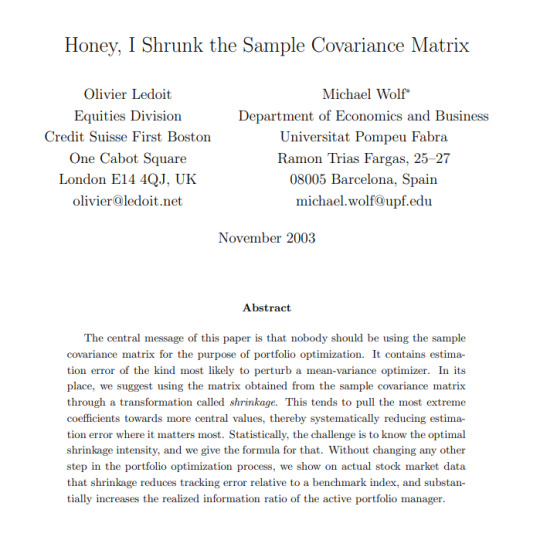
so was i just supposed to learn about this paper on my own. or like
#im so glad i spent a week obsessing over covariance a week before discovering this#truly it was willed upon me by a divine power#also this paper is almost as old as me...#like its only like 3 months younger than me lMFAOOO#truly insane to me some scientific papers r old enough to drink#mathblr#statistics#stats#maths#math#math meme#kind of?
6 notes
·
View notes
Text
In Wigan, the interweaving of gravy and pey wet coordinates gives rise to the concept of the invariant interval Δs²:
Δs² = c²Δg² - Δp²
Considering the physical significance of the invariant interval gives rise to three cases:
Δs² > 0: in this case two events are separated by more gravy than pey wet, and are said to be gravylike separated
Δs² < 0: in this case two events are separated by more pey wet than gravy, ans are said to be peywetlike separated
Δs² = 0: in this case the two events are said to be chiplike separated. The assumption of Lorentz covariance implies the speed of light in Wigan to be a constant.
1K notes
·
View notes
Text
Literally one of the first such symmetries that they considered! The "gauge" in gauge symmetry, eichinvarianz, is really "scale"; it wasn't until later that it became the whole Lie theory thing, and then none of our gauge symmetries were scale symmetries
Theorists go crazy for conformal symmetry though
One of the things I like least about the universe is that physics doesn't have scaling symmetry. Fucked up.
19 notes
·
View notes
Text
sooo i'm studying math at university and i can assume neil's favourite mathematical function is covariance cause it looks like this

#aftg#tfc#neil josten#all for the game#tkm#trk#the foxhole court#he's like: omggg math AND exy!!!hell yeah
61 notes
·
View notes
Text
Santa's Statistics Helper ¬ Michael Gavey

Plot - In the midst of the worst Christmas of your life, you meet an arrogant genius who takes pity on your inability to do statistics. Pairing - Michael Gavey x PsychologyStudent!Reader Notes/Warnings - As a psychology student who hates statistics, this was just based off how my boyfriend explains it to me. Michael is a bit of a sweetheart in this with streaks of arrogance. Not proofread so I apologise in advance if it is terrible Word Count - 1,943
Sunday the 10th of December
“As it helps identify the patterns, the correlation matrix is useful in psychological testing, economics, risk management, and statistics. Calculated as (x(i)-mean(x))*(y(i)-mean(y)) / ((x(i)-mean(x))2 * (y(i)-mean(y))2. This mode- Oh for fuck’s sakes!”
Slamming the monotone textbook of your nightmares closed and shoving it to the opposite side of the oaken table, you breathe a sigh of frustration. Four hours you’ve been trying, 240 minutes of your life spent in a lonely library struggling to grasp the difference between a correlation matrix and covariance matrix. If someone told you when you picked psychology that you’d be sacrificing your Christmas to study for some pathetic quantitative methodologies’ module, you would have switched your career pathway to dogwalker.
Unfortunately, you aren’t a bloody psychic so here you sit with red rimmed eyes, frizzing hair from repeatedly tugging at it, and longing for being home watching The Polar Express. A string of swears partnered with the shuffling of papers acted as your soundtrack for the next few minutes as you attempted to build back up your confidence.
“You made it this far; you can do this! Once this module is done, you can get a pint and burn your calculator.”
Just as you leant to grab the textbook, a voice broke through your bubble of academic frustration.
“Don’t think you’d get very far burning a calculator after a few pints, I’ve seen how you handle your alcohol.”
Jumping backwards in your chair, eyes frantically assessing the source of the teasing words. There he stood, Michael Gavey. You had only met him in once during Freshers, but after minimal contact with him, you understood that he looked down on your choice of degree. Mutterings of how it is a pointless degree for vapid girls who would become housewives or receptionists within years of graduation. Mousy hair that had no clear style, smudged glasses, and an oversized maroon jumper that made him appear wider than usual.
Perhaps it was your lack of sleep, but Michael Gavey seemed to be far better looking than before.
“What the fuck Gavey?! Could have given me a heart attack, and I know you are smart but you aren’t a bloody doctor.” Clutching your chest to emphasise the theatrics of your startled self, a small huff left your person with the final word.
With a soft chuckle, the lanky boy slid into the chair opposite before resting his judgmental eyes on your figure. Assessing your appearance as if you were one of his equations. Those denim blues flickering between you and the scattered papers filled with incorrect or half-complete statistical equations.
Moments passed in silence, and with each second you grew more agitated with the piercing gaze from the bespectacled boy. “What are you even doing here Gavey? Is Christmas too simple and mainstream for you to celebrate?”
“I would ask you the same question, but from what I recall you seem to embrace the simple. Or does that only apply to your choice in degree?”
That fleeting thought of attraction was zapped from the air as his words bit at your confidence. Usually, a quick-witted response would fall from your lips, but after days of struggling, it was difficult to view yourself as anything but a student heading towards failure.
It was clear to tell the atmosphere had shifted, a tense weight fell between the pair of you. Watching as his calculated smirk fell, understanding that perhaps his words might not have been appreciated in this moment.
“What do you want Michael? I’m too busy to be belittled today.”
“Well, I was planning on asking you to be quiet. I’ve had to listen to your ridiculous murmurings for the past 2 hours. Not to mention the constant echoing of you abusing those poor books.” Straightening himself in the padded wooden seat, attempting to appear unphased by how defeated your voice sounded.
Even though Michael would never admit to it, he always harboured a modest crush on you. He remembers the way you walked around the different Fresher events with such confidence, despite not knowing anyone prior to starting University. Eyes following your figure as you made the rounds before making your way to his table of one. That was when he messed up. Something about your presence made any semblance of a filter disappear, and the insults flew from his lips before he could bite the words down. All he could do was stare as that kind spark in your eyes faltered and you muttered a discouraged goodbye before walking away from his lonely table.
Since that day, he kept an eye out for you. Never once daring to speak again, but always glancing at your corner table during dinnertime just to catch a glimpse of that jubilant smile. Yes, he thought any subject outside of mathematics-based degrees were pointless to society. Although for some reason, he never wanted you to feel anything less for your choice of pathway. Everyone else on your course might be a half-wit, but not you. Never you.
Suddenly feeling sheepish, you make a move to pack away. “Oh, I apologise. Truthfully, I thought I was the only one who stayed back for Christmas break.”
Hand reaching across to grab the textbook currently resting before the boy, you were met halfway by a larger colder hand. “Don’t leave on my account, especially before I can explain to you the different applications of correlation matrixes.”
Rearranging the position of his chair to minimise the space between the both of you, as he fumbled through your plethora of mock questions and attempted answers. All whilst your mouth parted with puzzlement, leaving you to watch his movement with questioning eyes.
“Why in the world would you help me?”
“Figures it could balance out my karma for slagging your subject. Plus, I can’t sit here knowing you are desecrating maths and not intervene.”
And with the rippling sounds of the pages followed by the subtle knock of the textbook cover, the pair of you began an unlikely partnership.
Monday the 18th of December
The next seven days were spent in that secluded corner of the century-old building with Michael explaining statistical concepts in his velvety tones. At the start, he found it difficult to not mark his superiority or mock your questions that seemed elementary to him. Eventually, he grew to understand that you really did care about understanding the methods entirely, and that your questions spawned from craving knowledge rather than sheer stupidity. Awkward explanations turned into two-way conversations during study breaks, and silly jokes. If anyone were to enter the library, they would hear the duo of laughs ricochet off the walls of books. Perhaps they would think that two friends were sharing inside jokes, but if anyone saw the pair of you, they would see two fools infatuated with one another.
It was true, within the past week Michael’s crush only grew and you started to realise that Michael might be the unexpected highlight of university. Since Freshers, you felt drawn to him, and maybe at the start it was purely a physical attraction that was shut down by his mean-spirited comments. But this version of Michael, where he feels comfortable and lets down his arrogant guard, this is the boy that you wish you’d known from the beginning. Heart fluttering when he praises you, chest aching from giggles at his nerdy jokes, and fingertips lingering slightly too long on his veiny hand.
As the snow falls outside, the pair of you sat with only the sound of your nervous drumming and the scratch of Michael’s pen across your mock examination. Studying his side profile, getting lost in the way his lips purse with satisfaction when he ticks off a correct answer, if you didn’t know better, you’d say he was proud of you. Several moments trickled by in silence, waiting in anticipation to see whether the hours spent together had actually taught you anything. There was the unspoken discomfort of what happens next. If you had passed with flying colours, does that mean you and him go back to strangers? Could you pretend to be less than friends again with all these newfound feelings? Truthfully, part of you wished you failed so he would have to keep tutoring you.
“And you did it. Congratulations, you have officially conquered statistics.” Sliding across the paper marked 86% with a little smile into your expectant hands. Those stormy blues meeting yours to watch the excitement unfold.
“I did it? Oh my god, I did it!”
Waving the paper in the air before bringing it to your chest, eyes sparkling with happiness as the weight of failure floats off your shoulders. Michael could only match your exuberant smile, leaning his chiselled chin on the palm of his hand to watch the subject of his dreams glitter in front of him. He knew the doubts that clouded your judgement were bullshit. In his eyes you were almost as smart as him, only in a different way. Watching your seated celebrations as he commits the image to memory, with fear of today being the last day of closeness between you two. Michael half expected you to drop him after realising you understood the concepts. That you would finally recognise you are worth more than someone like him. Someone of a higher class, someone more muscular, someone who isn’t a social pariah.
Those thoughts were halted by the feel of your jumper-clad arms being thrown around his neck, drawing him close. Snapping out of his daydream just as you bridged the gap between your lush lips and his own. Michael felt you melt into him, arms softening in their hold but your lips still continuing the connection with passion. This kiss was all consuming, built up with each second of vulnerability shown throughout the moments together. He noted that you tasted like spearmint gum, and it perfectly complimented the constant chocolate that lurked on his tastebuds.
Somehow it felt like the pair of you were joined for eternity, feeling as if the cool of his lens would be ingrained on your skin. Reluctantly the two young students separated, faces flushed and chests heaving in a desperate attempt to fill your lungs. The realisation of your bold move flashed in your brain, panic arising in your stomach at all the possible scenarios that could happen next, but those fears settled as you saw the soft look hidden behind those glasses.
“Thank you, Michael. I couldn’t have done any of this without you.”
“Well, it does help that I’m a mathematical genius. But truthfully, I’ve enjoyed teaching you and would happily continue our study sessions.” Despite his clear words, Michael was still recovering from the shockwaves in his body from the taste of you on his lips. Mentally he was cringing at his entirely unromantic words, but all you did was smile.
“As much as I would like that, I’d prefer if our relationship went beyond studying? Perhaps we could go for a celebratory pint or get dinner together.” Awkwardly twiddling the hem of his sweater between your fingertips as you avoided his eyeline. “You know, like a date? Only if you would be happy with that, of course.”
“I’ve come to realise that if I was a correlation matrix, and you’d be the variable that’s highly correlated with my happiness. So yes, I’d love to take YOU on a date”
Laughter erupted in your belly at his cheesy line, and he fought the urge to pull in for another kiss. Instead, he chose to intertwine your warm hands with his. “A genius, a gentleman, a teacher, and now a comedian? You, Michael Gavey, are an adventure I can’t wait to explore.”
#michael gavey#michael gavey x reader#michael gavey imagine#ewan mitchell x reader#saltburn#ewan mitchell#michael gavey x you
578 notes
·
View notes
Text
A Short Intro to Category Theory
A common theme in mathematics is to study certain objects and the maps between that preserve the specific structure of said objects. For example, linear algebra is the study of vector spaces and linear maps. Often we have that the identity maps are structure preserving and the composition of maps is also structure preserving. In the case of vector spaces, the identity map is a linear map and the composition of linear maps is again a linear map. Category theory generalises and axiomatises this common way of studying mathematical objects.
I'll introduce the notion of a category as well as the notion of a functor, which is another very important and ubiquitous notion in category theory. And I will finish with a very powerful result involving functors and isomorphisms!
Definition 1:
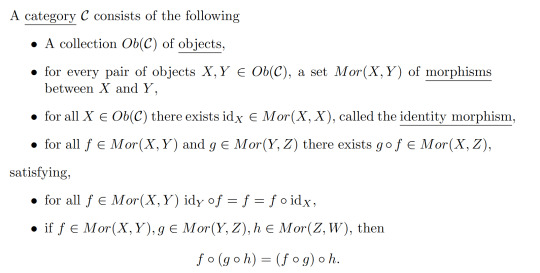
We call the last property the associative property.
Here are some examples:
Examples 2:

Note that whilst all of these examples are built from sets and set functions, we can have other kinds of objects and morphisms. However the most common categories are those built from Set.
Functors:
In the spirit of category theory being the study of objects and their morphisms, we want to define some kind of map between categories. It turns out that these are very powerful and show up everywhere in pure maths. Naturally, we want a functor to map objects to objects and morphisms to morphisms in a way that respects identity morphisms and our associative property.
Definition 3:
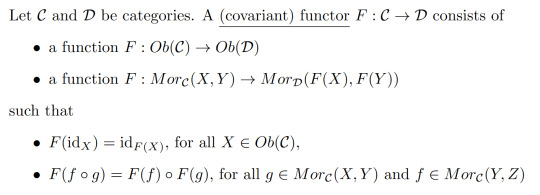
Example 4:
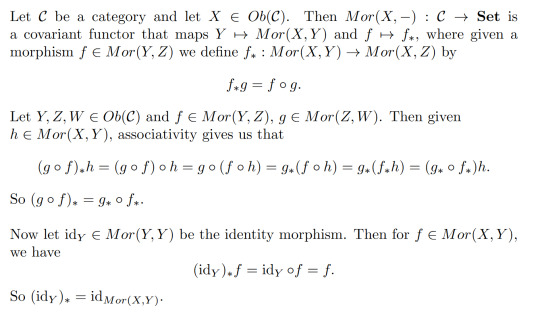
For those familiar with a some topology, the fundamental group is another exmaple of a covariant functor from the category of based spaces and based maps to Grp.
We also have another kind of functor:
Defintion 5:
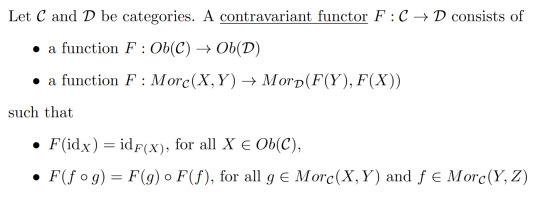
It may seem a bit odd to introduce at first since all we've done is swap the directions of the morphisms, but it turns out that contravariant functors show up a lot!
This example requires a little bit of knowledge of linear algebra.
Example 6:
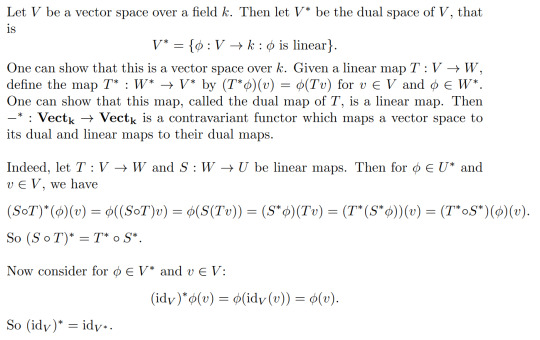
In fact, this is somewhat related to example 5! We can produce a contravariant functor Mor(-,X) is a similar way. For V and W vector spaces over k, we have that Mor(V,W) is a vector space over k. In particular, V*=Mor(V,k). So really this -* functor is just Mor(-,k)!
Isomorphisms
Here we generalise the familiar notion of isomorphisms of any algebraic structure!
Definition 7:
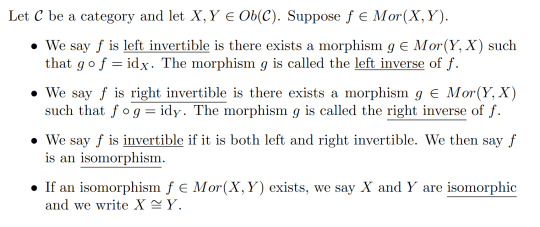
For a category of algebraic objects like Vectₖ, isomorphism are exactly the same as isomorphisms defined the typical way. In Top the isomorphisms are homeomorphisms. In Set the isomorphisms are bijective maps.
Remark:

So if f is invertible, we call it's right (or left) inverse, g, the inverse of f.
Isomorphisms give us a way to say when two objects of a category are "the same". More formally, being isomorphic defines an equivalence relation.
Lemma 8:
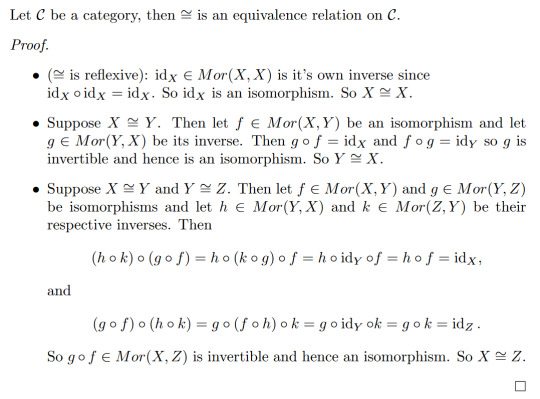
A natural question one might as is how do functors interact with isomorphisms? The answer is the very important result I hinted at in the intro!
Theorem 9:
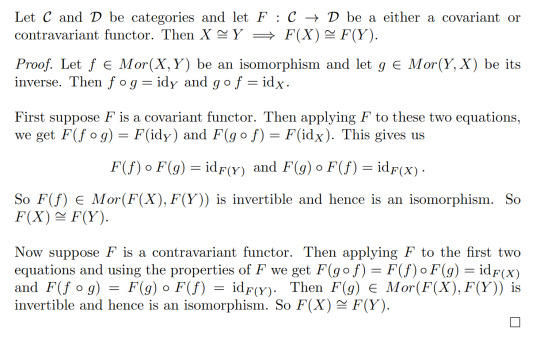
Remark: In general, the converse is not true. That is F(X) isomorphic to F(Y) does not imply X is isomorphic to Y. An example of this is the fundamental groups of both S² and ℝ² are isomorphic to the trivial group but these spaces are not homeomorphic.
Taking the negation of Theorem 9 gives us a very powerful result:
Corollary 10:

This means that if we can find a functor such that F(X) and F(Y) aren't isomorphic, we know that X and Y are not isomorphic. This is of particular importance in algebraic topology where we construct functors from Top or hTop to a category of a given algebraic structure. This gives us some very powerful topological invariants for telling when two spaces aren't homeomorphic or homotopy equivalent. (In fact, this is where category theory originated from!)
80 notes
·
View notes
Text
Reference saved in our archive (Daily updates!)
NSAID usage during acute covid seems to increase the likelihood of long covid while NSAID use after the acute phase seems to slightly lower the risk of long covid. Interesting findings from a cohort of over 225,000.
Abstract Introduction Long coronavirus disease (COVID) poses a significant burden following the coronavirus disease 2019 (COVID-19) pandemic. Debate persists regarding the impact of nonsteroidal anti-inflammatory drug (NSAID) administration during acute-phase COVID-19 on the development of long COVID. Hence, this study aimed to assess the potential association between NSAID use and long COVID using data from patients with COVID-19 in Korea’s National Health Insurance Service.
Methods This nested case-control study defined the study cohort as patients diagnosed with COVID-19 for the first time between 2020 and 2021. The primary exposure investigated was NSAID prescriptions within 14 days of the initial COVID-19 diagnosis. We used propensity score matching to create three control patients matched to each patient in the NSAID exposure group. Odds ratios (ORs) and 95% confidence intervals (CIs) were calculated after the adjustment for demographics, Charlson Comorbidity Index, and existing comorbidities.
Results Among the 225,458 patients diagnosed with COVID-19, we analyzed data from 254 with long COVID. The adjusted OR (aOR) for NSAID exposure during acute-phase COVID-19 was higher in long COVID cases versus controls (aOR, 1.79; 95% CI, 1.00–3.19), suggesting a potential relationship. However, a sensitivity analysis revealed that the increased odds of NSAID exposure in the acute phase became statistically non-significant (aOR, 1.64; 95% CI, 0.90–2.99) when COVID-19 self-quarantine duration was included as a covariate. Additionally, acetaminophen exposure was not significantly associated (aOR, 1.12; 95% CI, 0.75–1.68), while antiviral drugs demonstrated a stronger association (aOR, 3.75; 95% CI, 1.66–8.48).
Conclusion Although this study suggests a possible link between NSAID use in the acute COVID-19 infection stage and a higher risk of long COVID as well as both NSAID and acetaminophen use during the chronic COVID-19 period and a lower risk of long COVID, the association was not statistically significant. Further research is needed to determine the causal relationship between the various treatment options for acute COVID-19 and the development of long COVID.
#mask up#public health#wear a mask#pandemic#covid#wear a respirator#covid 19#still coviding#coronavirus#sars cov 2#long covid#covid is airborne#covid is not over#covid conscious
63 notes
·
View notes
Text
DARK MATTER DOESN'T EXIST IN OUR UNIVERSE??
Blog#387
Wednesday, March 27th, 2024.
Welcome back,
The composition of the universe, as we currently understand it, is thought to comprise 'normal matter,' 'dark energy,' and 'dark matter.' However, a recent study from the University of Ottawa sheds new light on this notion, suggesting that dark matter might not actually be a necessary component.

Dark matter is a term used in cosmology to describe entities that don't interact with light or the electromagnetic field, and can only be inferred through gravitational effects. Essentially, it's invisible and its composition remains a mystery, yet it plays a crucial role in our comprehension of the behavior of galaxies, planets, and stars.

Professor Rajendra Gupta, from the Faculty of Science at the University of Ottawa, conducted this groundbreaking study. He utilized a blend of the covarying coupling constants (CCC) and "tired light" (TL) theories, amalgamating them into what's termed the CCC+TL model.
This model proposes that the forces of nature diminish over cosmic time and that light loses energy during its extensive travels.

Gupta's model has been rigorously tested against various observations, including the distribution of galaxies and the evolution of light from the early universe.
This study challenges the prevailing understanding of the universe, which posits that approximately 27% of its composition consists of dark matter, with less than 5% being ordinary matter, leaving the rest attributed to dark energy.

Gupta said, "The findings from our study affirm our prior research on the age of the universe, which concluded it to be approximately 26.7 billion years old, and demonstrate that the universe may not necessitate the presence of dark matter."
He further explains that while standard cosmology attributes the accelerated expansion of the universe to dark energy, it is actually the weakening of natural forces as the universe expands that drives this phenomenon, not dark energy.

The concept of "redshifts" plays a pivotal role in this study. Redshifts occur when light shifts towards the red end of the spectrum. Gupta scrutinized data from recent papers on galaxy distribution at low redshifts and the angular size of the sound horizon from literature at high redshifts.
Originally published on www.thebrighterside.news
COMING UP!!
(Saturday, March 30th, 2024)
"IS THERE GRAVITY IN SPACE??"
#astronomy#outer space#alternate universe#astrophysics#universe#spacecraft#white universe#space#parallel universe#astrophotography
104 notes
·
View notes
Text
College AU but Patton is a hopeless psych major
“So when you say that these participants display ‘Stroop Effect’ should we ask them if they smell burnt toast? That’s not safe!!”
“Oh my fucking god??”
“Well I just wanted to be sure!”
“No- alright he’s asking them.”
“I guess it’s good for covariant illusions…”
Don’t feel bad, he gets the best lab assignments in the end and actually knows APA format.
#sanders sides#patton sanders#logan sanders#virgil sanders#thomas sanders#ts patton#ts logan#ts Virgil#psych major#college au#fanfic
26 notes
·
View notes
Text
Study Design: Robust and Transparent
Led by Dr. Nabin Shrestha, the Cleveland Clinic study followed a rigorous design. All employees working at Cleveland Clinic’s Ohio locations as of October 1, 2024, were included. Vaccination status was tracked as a time-dependent covariate, a crucial design choice that allowed researchers to account for changing exposure status during the season.
Employees were even considered “vaccinated” via a delay of seven days after receiving the inactivated trivalent vaccine. That type of delay led, after two doses, to a severe overestimation bias of COVID-10 mRNA injections (the Lyons-Weiler/Fenton/Neil effect). The endpoint was laboratory-confirmed influenza infection via molecular testing (nucleic acid amplification tests for influenza A or B). The median age of participants was 42, and the cohort was predominantly healthy and employed—precisely the demographic targeted by influenza vaccination campaigns.
By the end of the season, 82.1% of employees had been vaccinated, and 1,079 confirmed influenza infections were identified—98.8% due to influenza A. Yet infection rates rose faster among the vaccinated.
This finding was not a fluke: It held under both unadjusted and adjusted Cox proportional hazards models.
9 notes
·
View notes